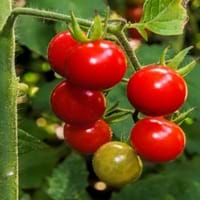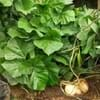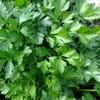Life Span
Annual
Perennial
Origin
Mexico, Central America, South America
Africa, Asia
Types
Red, Yellow and Baby Plum
Bigleaf hydrangea, Hortensia, Smooth hydrangea, Oakleaf hydrangea, Annabelle
Number of Varieties
Not Available
Habitat
Cultivated Beds
Forest edges, Hillside, Woods
USDA Hardiness Zone
11-15
10-12
Sunset Zone
A1, A2, A3, H1, H2, 1a, 1b, 2a, 2b, 3a, 3b, 4, 5, 6, 7, 8, 9, 10, 11, 12, 13, 14, 15, 16, 17, 18, 19, 20, 21, 22, 23, 24
21,22
Habit
Upright/Erect
Clump-Forming
Flower Color
Yellow
Lavender
Flower Color Modifier
Bicolor
Bicolor
Fruit Color
Red
White, Purple, Plum, Black
Leaf Color in Spring
Green, Dark Green
Green
Leaf Color in Summer
Green, Dark Green
Green
Leaf Color in Fall
Green, Dark Green
Green
Leaf Color in Winter
Green, Dark Green
Green
Leaf Shape
Lanceolate
Oblovate
Plant Season
Spring, Summer, Fall
Summer, Fall
Sunlight
Full Sun
Full Sun
Growth Rate
Fast
Very Fast
Type of Soil
Loam, Sand
Clay, Loam, Sand
The pH of Soil
Neutral
Neutral
Soil Drainage
Well drained
Well drained
Bloom Time
Indeterminate
Indeterminate
Tolerances
Drought
Drought
Where to Plant?
Container, Ground, Pot
Container, Ground
How to Plant?
Seedlings
Seedlings, Stem Planting
Plant Maintenance
Medium
Medium
Watering Requirements
Requires regular watering
Not Available
In Summer
Lots of watering
Average Water
In Spring
Moderate
Moderate
In Winter
Average Water
Average Water
Soil Type
Loam, Sand
Clay, Loam, Sand
Soil Drainage Capacity
Well drained
Well drained
Sun Exposure
Full Sun
Full Sun
Pruning
Dispose of diseased portions, Remove dead leaves
Remove damaged leaves, Remove dead branches, Remove dead leaves
Fertilizers
organic fertlizers
All-Purpose Liquid Fertilizer
Pests and Diseases
fungus
Red blotch
Plant Tolerance
Heat Tolerance
Drought
Flower Petal Number
Single
Single
Fragrant Bark/Stem
Yes
Yes
Foliage Texture
Medium
Medium
Foliage Sheen
Matte
Matte
Evergreen
No
Semi-Evergreen
Attracts
Butterflies
Bees, Flies
Allergy
Diarrhea, gastro-intestinal problems, Headache, Itchiness, Vomiting
Chest tightness, Diarrhea, Dizziness, Nausea, Vomiting
Aesthetic Uses
As decorated salad
Not Available
Beauty Benefits
Acne, Glowing Skin, Maintains teeth healthy
Not Available
Edible Uses
Yes
Not Available
Environmental Uses
Air purification
Air purification
Medicinal Uses
Antioxidants, Metabolism
Fever, Kidney problems, Urinary tract problems
Part of Plant Used
Fruits
Flowers, Root
Other Uses
Cosmetics, Culinary use, For making oil, Repellent
Not Available
Used As Indoor Plant
Yes
Not Available
Used As Outdoor Plant
Yes
Yes
Garden Design
Container, Edible, Herb, Vegetable, Houseplant
Container, Edible, Herb / Vegetable
Botanical Name
LYCOPERSICON esculentum 'Tiny Tim'
SOLANUM melongena 'Zebra'
Common Name
Cherry Tomato
Eggplant, Striped Eggplant, Zebra eggplant
In Hindi
चेरी टमाटर
Hydrangea
In German
Kirschtomate
Hortensie
In French
Tomate cerise
Hortensia
In Spanish
Tomate cherry
Hortensia
In Greek
Ντοματάκι
υδραγεία
In Portuguese
Tomate cereja
Hortênsia
In Polish
Pomidor wiśniowy
Hortensja
In Latin
Cherry LycopersiciSusceptibility
Hibiscus
Phylum
Magnoliophyta
Not Available
Class
Magnoliopsida
Not Available
Order
Solanales
Not Available
Family
Solanaceae
Solanaceae
Genus
Solanum
Not Available
Clade
Angiosperms, Asterids, Eudicots
Not Available
Tribe
Solaneae
Not Available
Subfamily
Solanoideae
Not Available
Number of Species
Not Available
Not Available
Importance of Cherry Tomato and Striped Eggplant
Want to have the most appropriate plant for your garden? You might want to know the importance of Cherry Tomato and Striped Eggplant. Basically, these two plants vary in many aspects. Compare Cherry Tomato and Striped Eggplant as they differ in many characteristics such as their life, care, benefits, facts, etc. Every gardener must at least have the slightest clue about the plants he wants to plant in his garden. Compare their benefits, which differ in many ways like facts and uses. The medicinal use of Cherry Tomato is Antioxidants and Metabolism whereas of Striped Eggplant is Fever, Kidney problems and Urinary tract problems. Cherry Tomato has beauty benefits as follows: Acne, Glowing Skin and Maintains teeth healthy while Striped Eggplant has beauty benefits as follows: Acne, Glowing Skin and Maintains teeth healthy.
Compare Facts of Cherry Tomato vs Striped Eggplant
How to choose the best garden plant for your garden depending upon its facts? Here garden plant comparison will help you to solve this query. Compare the facts of Cherry Tomato vs Striped Eggplant and know which one to choose. As garden plants have benefits and other uses, allergy is also a major drawback of plants for some people. Allergic reactions of Cherry Tomato are Diarrhea, gastro-intestinal problems, Headache, Itchiness and Vomiting whereas of Striped Eggplant have Chest tightness, Diarrhea, Dizziness, Nausea and Vomiting respectively. Having a fruit bearing plant in your garden can be a plus point of your garden. Cherry Tomato has showy fruits and Striped Eggplant has showy fruits. Also Cherry Tomato is not flowering and Striped Eggplant is not flowering . You can compare Cherry Tomato and Striped Eggplant facts and facts of other plants too.





